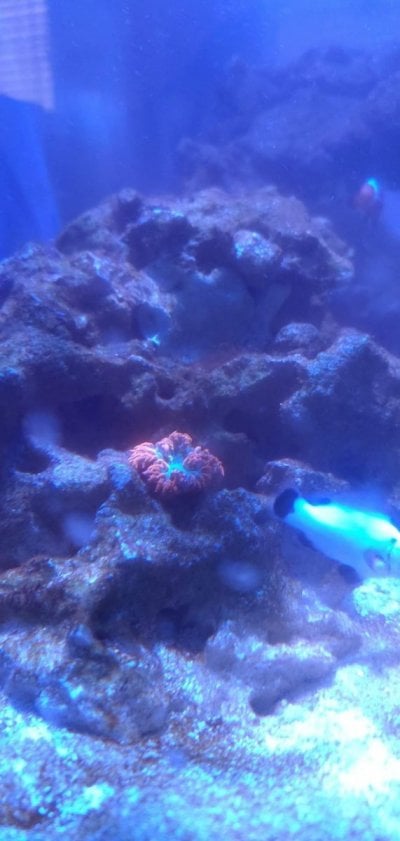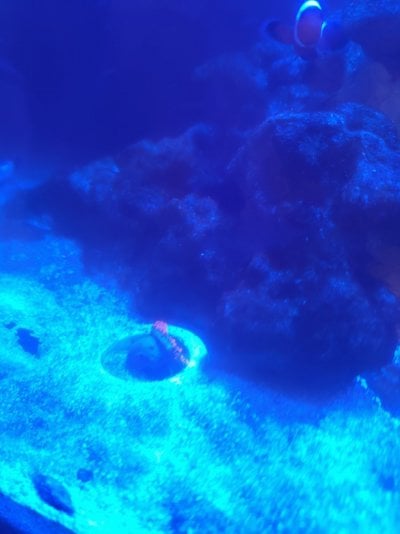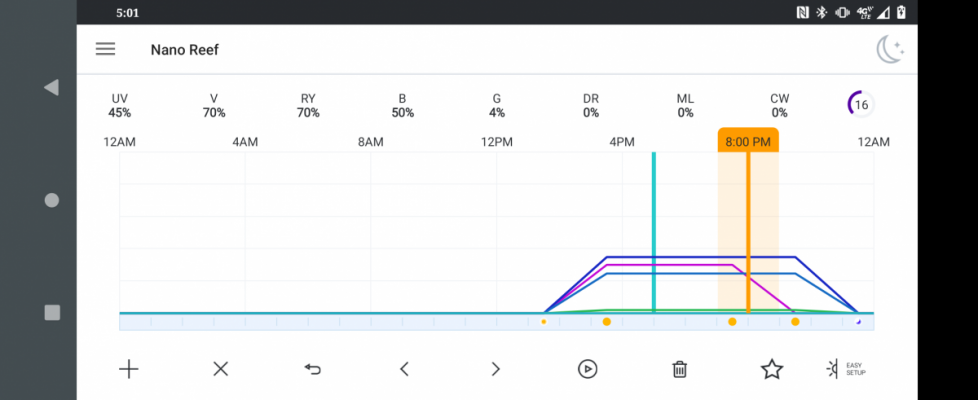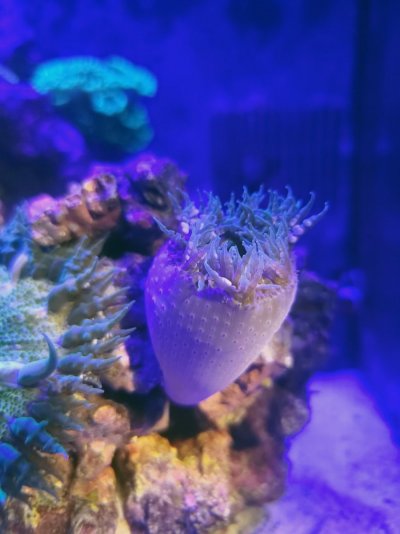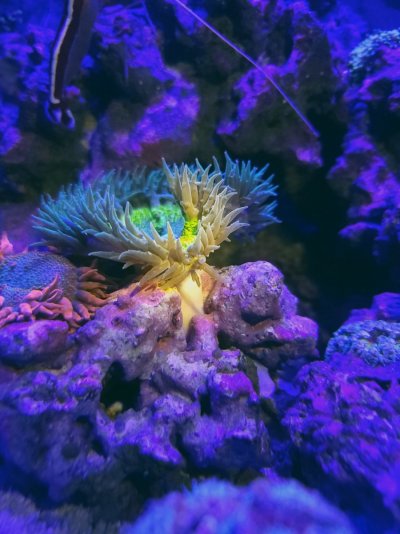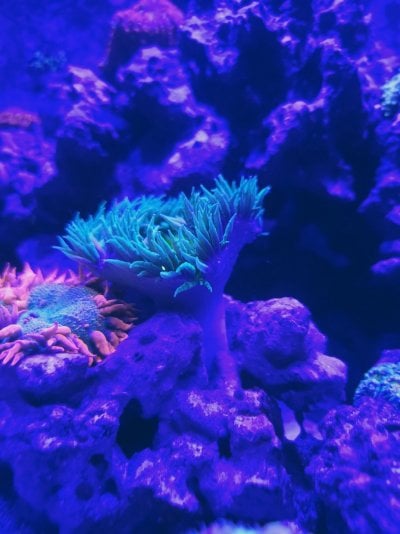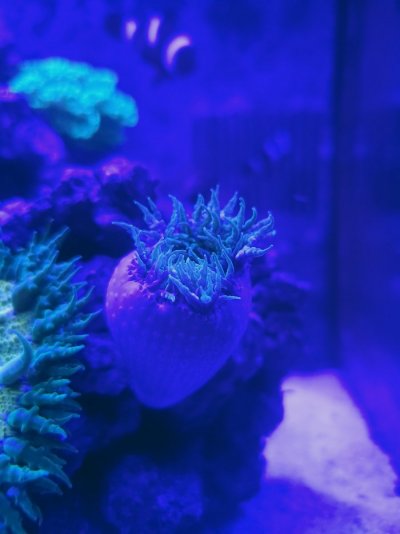RFAs will generally stay about where you put them. But they like to have their foot crammed into a crevice, and being able to stuff their foot under a rock, buried by sand, seems to be ideal.
Navigation
Install the app
How to install the app on iOS
Follow along with the video below to see how to install our site as a web app on your home screen.
Note: This feature may not be available in some browsers.
More options
You are using an out of date browser. It may not display this or other websites correctly.
You should upgrade or use an alternative browser.
You should upgrade or use an alternative browser.
Ron Reefman's Rock Flower experience
- Thread starter Ron Reefman
- Start date
- Tagged users None
- Joined
- Jan 5, 2019
- Messages
- 393
- Reaction score
- 584
They like both. Some prefer sand (and their foot attached to the glass of the aquarium) and some prefer crevices on rocks to anchor their foot to.So I'm a little confused on this. My goal is to have my tank dedicated just to RFAs, similar to what VIP Reef in Miami has (see attached photo), and theirs are all over the rocks. What would RFAs prefer being in the sand over being on the rocks?
When they get large enough, how do you remove them from the end cap? Were the babies easy to grab and put in the end cap when you found them?So i kept finding more babies here and there for a few days. I'm now up to 22! They are growing nicely in their little endcap.

- Joined
- Apr 20, 2019
- Messages
- 14,355
- Reaction score
- 22,035
When they get large enough, how do you remove them from the end cap? Were the babies easy to grab and put in the end cap when you found them?
I just gently scraped them off with a plastic pipette. The majority of them were found in the sand, so I was able to gently scoop them up or suck them up with a long coral feeding tube.
So I'm a little confused on this. My goal is to have my tank dedicated just to RFAs, similar to what VIP Reef in Miami has (see attached photo), and theirs are all over the rocks. What would RFAs prefer being in the sand over being on the rocks?
When they get large enough, how do you remove them from the end cap? Were the babies easy to grab and put in the end cap when you found them?
RFAs are about equally happy on a rock or in the sand (PROVIDED THEY HAVE SOMETHING HARD TO ATTACH TO LIKE AN END CAP OR A BURIED ROCK). We see them if both places when we snorkel in the Keys.
I take the end cap with a RFA inside and run cool, fresh water over the back side of the end cap while holing it upside down so the RFA hangs out. They are MUCH easier to get out of an end cap than they are to get off (or out of) a rock.
- Joined
- Jun 4, 2016
- Messages
- 1,001
- Reaction score
- 455
I noticed mine will start moving when freely sitting in the sand even with the foot stuck to the glass bottom. I jam a couple rock rubble next to them and noticed they'll move towards it then stay put.
Great tip @Ron Reefman I was wondering how to get them out of the end cap. I considered cutting the end cap walls away to allow a credit card to get under the feet. Didn't think about the cold water to cool down the cap and foot and they'll release.
Great tip @Ron Reefman I was wondering how to get them out of the end cap. I considered cutting the end cap walls away to allow a credit card to get under the feet. Didn't think about the cold water to cool down the cap and foot and they'll release.
I need some advice. This is my first RFA and I got him last Tuesday. At first he attached to the rock in a hole, picture one. But the next day I found him on the gyre pump I have (Reef wave 25 set at 50%). I shut it off and got him off of it so he wouldn't get sucked into it. After setting him back down on the sand, 2-3 hours later he was face first at the pump again. Repeated and placed him on the other side of the tank away from any pumps and he rolled around to the intake of filter and closed up. I was afraid he would get sucked in again. I read on here that placing them in endcaps seems to make them happy so I picked one up, put some sand in it and laid him on it. He stayed put but just looks sad like this and won't attach. I think the first time he got stuck on the pump damaged his foot and that's why he's not settling. The tank is a 6 month old 20g long tank with 2 AI Prime HD16, current light settings are down below that I modified from 2 different profiles online. Water tested at; Ammonia 0, n02 0, n03 0, p04 0, ph 8.4, salinity is 1.026. Sorry for the long post, I just want to know how to help this guy and have a happier tank. Only thing I can think of that he doesn't like is the diatoms that won't go away for over a month now.
Attachments
Can you put a bit of food on his tentacles and see if that makes it perk up?
It opened up a bit so I tried feeding by syringe with mysis shrimp and tongs. It didn't seem to want to grab on to the food I tried to feed him.Can you put a bit of food on his tentacles and see if that makes it perk up?
So looking at your numbers, from what I understand, 0 PO4 and 0 Nitrate is not what corals like. Atleast 0.03 for PO4 and at least 3 NO3 is the lowest for a tank, more so for SPS but nems like dirtier water. I hve my RFA/ mushroom tank with some of both. I suggest feeding more or dosing PO4 and NO3..just my thought. How is your RFA doing now?
It didn't survive, one of the hermit crabs took to him the next day and it didn't pull through. I am making slow adjustments to raise the parameters naturally by removing some of the filter media slowly. I was using chemi-pure elite to get rid of brown diatoms but mis-diagnosed it and it was dinos. Didn't know at the time I needed the Po4 for the RFA or to keep dinos at bay so I am working to get the numbers of Po4 up to snuff. My tank is doing some swings again at the moment, so just going to take my time.So looking at your numbers, from what I understand, 0 PO4 and 0 Nitrate is not what corals like. Atleast 0.03 for PO4 and at least 3 NO3 is the lowest for a tank, more so for SPS but nems like dirtier water. I hve my RFA/ mushroom tank with some of both. I suggest feeding more or dosing PO4 and NO3..just my thought. How is your RFA doing now?
I am sorry you lost the RFA. I am glad to hear you are working on raising the parameters. I am sure you have heard the reef mantra… patience is key in this hobby.It didn't survive, one of the hermit crabs took to him the next day and it didn't pull through. I am making slow adjustments to raise the parameters naturally by removing some of the filter media slowly. I was using chemi-pure elite to get rid of brown diatoms but mis-diagnosed it and it was dinos. Didn't know at the time I needed the Po4 for the RFA or to keep dinos at bay so I am working to get the numbers of Po4 up to snuff. My tank is doing some swings again at the moment, so just going to take my time.
Oh yes, I engrained it from day one. I try to make one change no less than a week before I even attempt another change of something. I noticed a massive swing of parameters when I dose with Coralife Nano Reef part A and B. So I stopped dosing those and dose instead the Po4 as needed to raise it. Should I stop using chemi-pure elite all together though as it lowers phosphate and just use carbon? Also I don't have a hanna checker to test ulr Po4. I got what my lfs had at the time and it was a fluval kit.I am sorry you lost the RFA. I am glad to hear you are working on raising the parameters. I am sure you have heard the reef mantra… patience is key in this hobby.
I personally only use Chemi pure when I have a PO4 problem, which sadly is more often then not. In between I use regular carbon and change it out once a month. My corals, no acros, are happy even with my PO4 being 0.07-0.90. Yes, you read that right! Recently I tried to go ULN and trashed my tank. Diatoms, hair algae, and green slime! I have since recovered and just recently re-aquascaped in hopes that maybe the rocks were holding the PO4. I will know in another week or so.
Ultra Low Nutrients, phosphate and nitrate . From what I understand PO4 should be 0.03 and NO3 under 5…I have never been able to achieve it and when I did try, my tank went to S-IT.What is ULN if you don't mind me asking? Is that short for ultra low nitrate
- Joined
- Dec 12, 2018
- Messages
- 192
- Reaction score
- 201
Fed my little RFAs for the first time today, some thawed hikari mysis. Sucked up a few in a pipette and squirted it above one of them and the instant the mysis contacted it's face it absolutely devoured the shrimp. I was blown away at how it instantly identified it as food, as I've observed equal sized particulates fall on it during a water change and it didn't react at all.
Fun creatures to watch!
Fun creatures to watch!
Around 8pm EST today I'm pretty sure we witnessed our 2nd spawning event of the year. The first one was on MLK day so about 3 months apart from one another. We did get babies out of our first event. I counted 26 at the highest around the beginning of March but now I only see about 10. Hoping that tonight's spawning even yields some more babies.
Attachments
Thank you very much for all the information and the amazing pictures!I've been in love with anemones even before I was started in this hobby about 15 years ago. I really got crazy about them when I started to collect some while snorkeling in the Florida Keys (with the proper license) about 12 years ago. I totally fell in love with the very colorful Rock Flower anemones when I first saw them at the VIP Reef (LFS in Miami) display at Reef-a-Palooza in Orlando, FL in 2014. But what drove me over the top was when 2 of my Rock Flower anemones got together and had babies about a year ago! These are the two parents.
P9290013 by Ron Lindensmith, on Flickr
P9290014 by Ron Lindensmith, on Flickr
I never saw the spawning event or the actual birth of the babies. In fact it was my wife that discovered a bright orange "dot" on a rock and she asked me what it was? It was the first of about 8 or 10 babies we eventually found in the surrounding area.
P9290007 by Ron Lindensmith, on Flickr
P9290005 by Ron Lindensmith, on Flickr
Over the next 8 months we watched them slowly grow. There are a variety of color variations but most were either mostly orange face & green or white tentacles like one parent or mostly all green which isn't like either parent.
Then about 2 months ago we decided to sell our 120g DT and just keep the 50g cube. This was our original system.
20170223_155902 by Ron Lindensmith, on Flick
And this is the currently the setup of the 50g cube that we parted out of that system. It is a work in progress.
20180622_143629 by Ron Lindensmith, on Flickr
But as I was selling off a lot of coral from the 120g tank, I started finding a few more Rock Flowers growing in with big zoa populations. They can be very difficult to see, especially when the are even smaller than the zoas they are living with! Here is a pic of two that I saved by cutting a cube out of the bigger rock with a big zoa colony.
20180622_143853_resized R1 by Ron Lindensmith, on Flickr
I even saved a few others that weren't at the edge of the rock by using a small diamond edge glass cutting hole saw! The little cores of rock, nem and a few zoas fit nicely inside a1/2" PVC end cap.
All that was good and I had about 15 to 18 Rock Flowers. They were all moved to the 50g cube and seemed to be doing just fine. The 120g tank, stand, sump and other hardware all sold to one buyer and was moved from our house. The surprise came when we discovered an entire new batch of tiny Rock Flowers now in the new tank! Most of them were in the area of the parents, but some had moved all over that tank. In total I now have about 35 Rock Flowers anemones, but most of them are still quite small. Here is a very small rock that was near the parents with about 8 or 9 Rock Flowers anemones on it. I pulled the rock and put it in a small glass cup to take this photo.
20180622_144303 R1 by Ron Lindensmith, on Flickr
Other babies are in the sand.
20180622_143722_resized R1 by Ron Lindensmith, on Flickr
And one even found its way up to the magnet at the back of the powerhead at the back of the tank!
20180622_143728_resized R1 by Ron Lindensmith, on Flickr
Here are a couple shots of the parents and some of their kids as of today.
20180622_144452 R1 by Ron Lindensmith, on Flickr
20180622_143642_resized by Ron Lindensmith, on Flickr
I don't claim to be any kind of an expert when it comes to Rock Flower anemones. In fact I'd love to chat with anybody who know anything about them and share info. If anybody has any questions for me, I'm happy to try and answer them. And when I do, I'll be clear about what I know for a fact, what I've heard from others that I trust, and what I've heard or read from other less reliable sources.
And if anybody has any questions about my collecting while snorkeling in the Florida Keys, I'll be happy to share that info as well. In fact we were just there and I brought back on Rock Flower anemone from the shallow waters (2' deep) which are much less colorful than the spectacular colored ones that I understand come from 30 to 50 feet deep. This is the one I collected in its original home off Vaca Key (the city of Marathon) at a tiny island less than 1/2 a mile out from the motel we say at!
Rons rock flower anemone by Ron Lindensmith, on Flickr

Ok, little late to the party!! But, dang, your advice about the PVC cap was awesome! Bought two RFA’s a couple days ago from the LFS. Yikes! I will remember which day’s certain peopleLet’s discuss where your RFA’s are in your tank, i.e. on the rocks, at the edge of a rock, in the sand or do you have some other location?
In the wild, the shallow water RFA’s that I see are almost always attached to rocks that have a hole. The nem sets its foot in the hole and can retract into the hole when disturbed or when ingesting food it has caught. Many of them are in holes on the vertical surface of the rock and away from the sand. But almost as many or in holes that are on horizontal surfaces and may have sand around them as well. Sometimes there is no sand, sometimes just a little sand and sometimes the sand is 2 or 3” deep.
The first time I tried to place a number of RFA’s on a flat rock, they all moved to the edge of the rock at the sand. Some even attached just under the bottom of the flat rock and reached up around the edge to be above the sand. However, I have seen a couple of photos of people’s tanks with RFA’s attached to rocks well up away from the sand. I assume these nems have their foot in a hole they like and are happy there as well.
What I’ve been doing most recently is buying various sizes of PVC end caps. Before I put a new RFA (or move one for some reason) I pick an end cap that is just a bit bigger in diameter inside than the RFA’s foot (yes, it’s a real guessing game). Then the PVC end cap and RFA go into a 16oz deli cup full of tank water. About 95% of the time, the nem settles down inside the PVC end cap and attaches. It may happen quickly, it may take a couple of days. Then I can take the PVC end cap and transfer it to the tank. I push the end cap down into the sand so that just a tiny bit of the end cap’s rim is exposed above the sand.
At this point I’ve never had a RFA move from the end cap. After a week or so, I’ll often go back and push the end cap down just a bit more so the rim disappears in the sand. At that point the sand will start to get inside the end cap with the nem. I have 10 of my bigger RFA’s in end caps now. The other 20+ RFA’s in my tank are loose and fending for themselves. Most of them fairly small and attached to the edges of rocks at the sand.
I like this way of keeping some of my RFA’s. It allows me to keep the bigger, more mature and possibly ready to mate nems close to each other for better potential spawning. It also makes it really easy to pull one out of the tank if I decide to sell one to a friend or customer who comes to my house and falls in love with them. And I have to admit, that does happen quite often! That visitors fall in love with them, not that I sell them… at least not until they’re about 2” in diameter.
Here is a photo where a couple of the RFA's are a bit retracted and you can see the PVC end caps.
20180622_144452 R1 by Ron Lindensmith, on Flickr
Thank you very much for all the information and the amazing pictures!
Similar threads
- Replies
- 7
- Views
- 229







